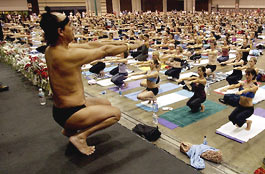
Photo: AP/Wide World Photos
ON A MONDAY AFTERNOON in downtown Los Angeles, the famous yoga teacher’s disciples gather in a large, rectangular room heated to more than 100 degrees. Solemn, half-naked men with lithe torsos stare into the distance, quietly focusing their energies. Young women in leotards limber up, arching their spines and exhaling in unison with a loud whooshing noise.
Just before 5 p.m., a Rolls-Royce pulls up outside, and moments later the guru strides in. This afternoon, Bikram Choudhury—Bikram, as he’s universally known—is wearing a diamond-studded Rolex, a headset microphone, and a tiny Speedo. He climbs onto a padded chair raised like a throne in the front of the room, looks down upon his hushed followers, and begins leading class.
And when Bikram speaks, he doesn’t exactly talk in soothing tones. “Arms over the head, let’s go,” he shouts. Middle-aged and in phenomenal shape, he points out flab and mocks people who are not bending fully. Then he segues, without warning: “I’m feeling sleepy, because I haven’t gone shopping for a long time…. I haven’t bought a car for two years—no, I bought a car last month, the fancy new Chrysler. Okay, move your right leg. Now your left leg.” A few more exercises, another non sequitur: “What is the number-one reason people get divorced in America? Why do men leave? Because they don’t get according to their expectations…. Men have an imbalance of hormones. But yoga helps men maintain [sex drive]. Shit! Shit!”
For the next 90 minutes, the scattershot, profanity-laced, name-dropping monologue continues, with Bikram rapping in mellifluous, Indian-accented English on a range of topics—the yoga routine, the world’s finest automobiles, women he’s known. Halfway through class, he abruptly stops and takes a long swig of Coke. He stands up, grabs his trunks, and lets out a loud belch. When he’s finished burping, he holds his crotch tighter and thrusts wildly, screaming, “I am a Bengal tiger! I am a Bengal tiger!”
The crowd laps it up. They respond in unison to Bikram’s questions, laugh at his jokes, and follow his exhortations, sometimes grimacing in pain. After class Bikram, still clad only in the Speedo, strides to his office, squats on a chair, and leans over his desk, peering into my face as he yells, “There is nothing like this happening anywhere in this country, or in the world.”
That would be an understatement. In fact, in the process of seeking more control over the growing American yoga market (at least 16.5 million people now practice yoga, according to Yoga Journal), Bikram has broken brand-new ground for his age-old discipline by seeking to copyright a sequence of yoga poses and set up hundreds of Bikram franchises around the country. He has also used his considerable fortune to go on the legal offensive, threatening to sue studios that use the poses and breathing exercises he practices without crediting him. His attempt has frightened many traditional teachers, who worry about the future of yoga and other communal disciplines that have evolved over centuries, in large part through the sharing of ideas. Unfortunately for Bikram, it turns out that even though yogis are supposed to reject all material attachments, many studio owners aren’t giving up their businesses without a fight.
BORN IN CALCUTTA IN 1946, Bikram came to the United States in the early 1970s to teach hatha yoga, the most exercise-oriented type of yoga. (He says he was brought in to teach Richard Nixon, a claim that has proved impossible to verify.) He opened his first studios in California and Hawaii, where he combined a series of 26 hatha postures and two breathing exercises, all to be performed in a superheated studio, into a 90-minute sequence that he narrated. “Hot yoga,” which he would sometimes call “Bikram yoga,” proved enormously popular, even life-changing for many practitioners, who loved its intensity and its discipline, and who found that the heat helped them push their bodies beyond anything they’d imagined. By the late 1970s Bikram had written a book, opened more studios, and started training yoga teachers at his Los Angeles headquarters. “Before me, there was no money, no business with yoga,” Bikram says.
Still, back then, he made no attempt to trademark his name or poses. His students often returned to their hometowns to launch studios; today, Bikram says, more than 1,200 studios nationwide practice some form of hot yoga. Sometimes the former students would advertise that they were teaching Bikram-style yoga. Sometimes they wouldn’t. “Bikram’s sequence wasn’t entirely original,” says Jimmy Barkan, a studio owner in Florida who trained with Bikram. “There are many parts of it that were commonly practiced for years.”
As his wealth and celebrity grew, Bikram became more intense. His talk in class grew bolder. “He’d talk about some girl’s breasts, or tell stories about how all the women in L.A. were walking funny after intercourse with him,” says one former student. He promised he could cure cancer and boasted of his famous clients and friends; the walls of his Los Angeles studio are plastered with photos of him with the likes of Shirley MacLaine, Luke Perry, and Bill Clinton. (Clinton, in a note displayed near the picture, thanked Bikram after visiting him in Beverly Hills—to get yoga training, Bikram claims; Clinton’s press office did not return calls on the subject.) “From pope to president to prime minister, billionaire, superstar, novelist, sportsman, athlete, hooker, street boy, they say, ‘Bikram, you changed my life, you saved my life,'” he told me. “I have balls like atom bombs, two of them, 100 megatons each,” he informed Business 2.0. “Nobody fucks with me.”
Bikram’s business goals also became more ambitious. Rather than simply own studios and train teachers, he now aims to turn his disciples into franchisees and give hot-yoga enthusiasts nationwide the exact same experience, from the poses down to the instructor’s monologue. As with Starbucks, he figures, familiarity will prove attractive to Americans—and lucrative, too, with potential for licensing deals galore. “Bikram yoga is so big—this is a bathroom slipper you buy [for] $2 in Kmart,” he says, waving a plastic flip-flop in my face. “But you put ‘Bikram’ on it, it’ll sell for $35 in a second.”
Over the past two years, Bikram has applied for trademarks for his name and copyrights for his teaching materials and sequence of 26 poses and two breathing exercises. His lawyers have begun sending out cease-and-desist letters warning other teachers not to adulterate his sequence or take credit for it or anything derivative of it. He has also sued or threatened to sue studio owners, forcing at least one to settle and promise to “never again…infringe upon Bikram’s copyrighted works.” On the website of his organization, Bikram’s Yoga College of India, he has posted a statement threatening to sue anyone who does not obey, demanding $150,000 for each supposed violation. “If anyone steals your intellectual property, you shut them up,” he says, his voice rising. “Do you think I feel very happy to do that? Of course not. In India, nobody sues anybody.” He sighs. “You guys bring me [to America] to teach yoga. Just simple, teach yoga. Now look at where you’ve put me today. Why, my friend said to me, ‘You don’t look good’—because all the time I have to think about law and justice and courts.”
Clearly, many of Bikram’s former students remain close to him and might happily join a franchising model. Still, others see a darker side to the concept. “Litigating to take control is so much the antithesis of yoga,” says Dharmanidhi Sarasvati, a classical yogi in Berkeley, California. “It’s the culmination of commercialization.” Sarasvati says that in India, yoga was explicitly anticommercial: Teachers shared information in order to boost their knowledge, and disciples did not pay to learn from masters.
Phil Catalfo, an editor at Yoga Journal, says Bikram’s efforts “could have huge implications.” If Bikram succeeds, he may prompt other companies to patent and franchise ancient shared ideas. Several other yogis are allegedly researching ways to copyright their sequences. A company that produces video games has sought to own the rights to age-old elements of karate. Some Pilates studio owners and equipment makers have tried to trademark the practice, a form of exercise invented in Europe a century ago. So far, none of these efforts have been successful, but Bikram believes he can establish a precedent.
It won’t be easy. In the mid-1990s, Vanessa Calder and her parents, Bill and Sandy McCauley, used their life savings to build three small studios in the San Francisco Bay Area, which they named Yoga Loka. The studios were cramped quarters, some on second-floor walk-ups, with rooms barely big enough to hold 30 people. Calder’s father, a former construction worker, designed the studios, and her mother, who’d used hot yoga to cure numerous health ailments, became the first teacher. “The yoga is wonderful, and so is Bikram’s service—that he brought this yoga here,” says Calder, a tall, narrow-faced woman with streaky blond hair.
In 2000, the McCauleys, who’d taught primarily hot yoga but wanted the freedom to teach other styles, declined an offer from Bikram to become “affiliates” of his, which would have meant teaching only Bikram-style yoga. They soon received a cease-and-desist letter telling them to quit using the Bikram name. “Now we were all very afraid,” Calder remembers. “We’d never had a lawyer before, and we were terrified. My mother felt like she could lose her livelihood—she has no savings.”
Last year, Calder and a group of instructors from across North America formed a coalition called Open Source Yoga Unity—inspired by the open-source software movement, which has tried to break Microsoft’s dominance over computer operating systems—and sued Bikram in federal court in California. “I said, I’m not going to live in fear forever,” says Brandon Hartsell, an Open Source member and owner of a Dallas studio that teaches some hot yoga. Open Source is asking the court to prohibit Bikram from threatening to sue studios, and to declare a limit to his rights under copyright and trademark law. In April 2004, the judge rejected Bikram’s attempt to have the Open Source suit dismissed. The case is now in discovery, preparing for trial.
The wrangling has frightened some yoga teachers. Calder says that when she invites instructors to join Open Source conference calls, many are too afraid to identify themselves on the line. Numerous studio owners also refuse to discuss Bikram in print. One young woman who used her savings to open a small studio spoke with Mother Jones on condition of anonymity. “I gave Bikram every cent I had,” she said. (Bikram training costs $5,500.) “Then I had to take out a $30,000 loan to open my studio. I didn’t think I should have to pay Bikram to open a studio…. The whole franchise thing is bullshit, totally opposite what yoga should be, but I’m trying to survive.” She paused, resigned. “I’m considering just going back to Bikram and begging him to sign up for a franchise.”
If Bikram is in one of his magnanimous moods, he might take her back. Leaning back in his plush chair with a broad smile, he reminded me how lucky America is to have him. “I didn’t come here without a visa, like everyone from China and Vietnam and Cuba. I came here by special plane…received by the ambassador, by the president of the United States. I should be the most honored man in your country. Why do I have to go through these things today?”















